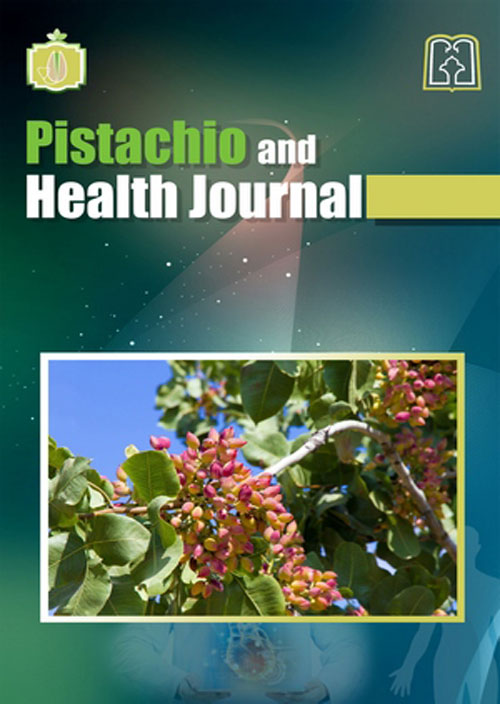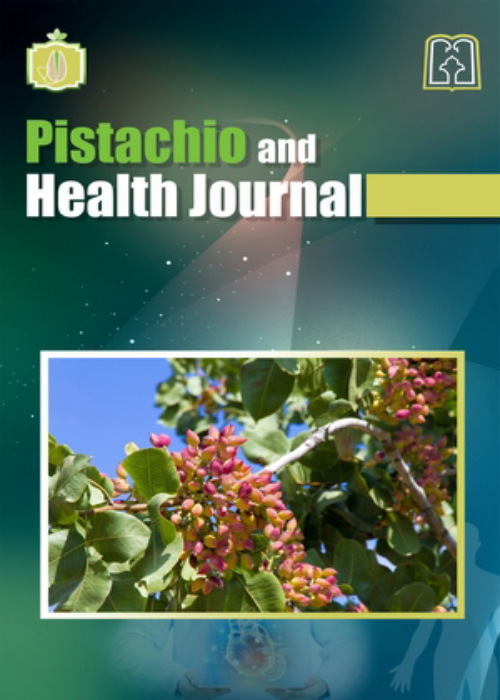فهرست مطالب

Pistachio and Health Journal
Volume:4 Issue: 1, Winter 2021
- تاریخ انتشار: 1400/03/18
- تعداد عناوین: 8
-
Pages 7-17Introduction
Pistacia khinjuk is traditionally used in folk medicine for the treatment of various disorders. This study was aimed to investigate the effect of Pistacia khinjuk fruit extract on some selected biochemical parameters using rat model to validate its application in traditional medicine.
Materials and MethodsThe fruits of the plant were air-dried and the hydroalcoholic extract was obtained. Twenty-four rats were divided equally into three groups: one group served as the control group and the rest as test groups. The test animals were treated with two concentrations of Pistacia khinjuk(200 and 400 mg/kg) orally for twenty-eight days. The biochemical data were analyzed using SPSS software, expressed as means ± SD and were subjected to one-way analysis of variance (ANOVA) followed by post-hoc Tukey.
ResultsThe results obtained for the selected biochemical parameters revealed that glucose, triglyceride, Blood Urea Nitrogen (BUN), creatinine, urea, bilirubin and GGT levels decreased significantly (p < 0.05) in test groups against the control group. The HDL level increased in test group 1 (200 mg/kg), and Cholesterol, AST and ALT levels decreased significantly in test group 2 (400 mg/kg) (p < 0.05) compared to the other groups.
ConclusionThe present study showed that the fruit extract of Pistacia khinjuk possesses hypocholesterolaemic properties, has a glucose-lowering effect, improves the lipid profile, and may be of enormous benefit in the management of diabetes, cardiovascular, renal and hepatic diseases.
Keywords: Pistacia khinjuk, hydroalcoholic extract, biochemical parameters, hypocholesterolaemic properties, glucose-lowering effect -
Pages 18-29Background
Menopause reduces sexual hormones in female rats and is accompanied by depression and emotional disorders. Flavonoids of pistachios have anxiolytic, sedative, and anticonvulsant properties.
ObjectivesThe current study aims to investigate effects of pistachio oil on behavioral disorders of ovariectomized rats.
Material and MethodsAs many as 35 female Wistar rats (150-200g) were randomly divided into five groups (n=7 in each group). In the sham group, the animals received standard drinking water after surgery. In the OVX.C group, the ovariectomized rats received standard drinking water. The ovariectomized rats in the OVX.P group received Premarin (64.5µg/kg) for 28 days. In the h1 300 and h1 1200 groups, the ovariectomized rats received 300 and 1200mg/kg/day of pistachio oil orally for 28 days, respectively. Besides, anxiety was evaluated by the elevated plus-maze (EPM) and open field tests (OFT).
ResultsAccording to the results, oral administration of pistachios significantly increased the percentage of the open arm entries (OAE) test approximately three folds in the h1 300 and hi 1200 groups (P < 0.05). In addition, the percentage of the OAE test was raised in the OVX.P group compared to the OVX.C group (P < 0.05). Besides, the percentage of the open arm time was higher in the OVX.C group than in the sham group (P < 0.01). Anxietyline behaviors in the ovariectomized rats showed a smaller inner time parameter as observed in the OVX.C group compared to other groups. Besides, it was reduced significantly compared to the sham group (P < 0.01). Furthermore, there were no significant differences in the velocity parameter in all treated groups compared to the sham and OVX.C groups.
ConclusionsThe results of this study implied that pistachios had protective impacts on anxiety-like behaviors in ovariectomized rats; therefore, pistachio oil could be used as an effective remedy for alleviating anxiety in menopausal women.
Keywords: Rat, Pistacia vera, menopause, Anxiety behavior -
Pages 30-50Introduction
One of the issues in pistachio orchards is the wide range of fluctuations of crop yield in different years. These fluctuations have resulted in different yield of dry crop per hectare in different years. Thus, the two indicators i.e. pistachio yield average and pistachio yield fluctuations are effective in creating a suitable and reliable income for farmers; it is important to identify the factors affecting these two indicators.
Materials and MethodsIn this study, by using 9-year-old data (2010-2018) of 286 pistachio orchards from 4 commercial pistachio cultivars; Ahmad Aghaei, Akbari, Kaleghoochi, and Ohadi in two cities i.e. Anar and Rafsanjan in Kerman province, it was attempted to investigated different factors affecting time series fluctuations of pistachio yield. In this regard, two indices i.e. coefficient of variation and probability of yield loss to less than long-term average, 1000 kg of dry pistachio per hectare, were used.
ResultsIn terms of crop yield’s coefficient of variation, Ohadi (cultivar) had the least fluctuation, Kaleghoochi showed the highest fluctuation, and Akbari and Ahmad Aghaei were reported to have an average fluctuation. As for probability of crop yields falling to less than a certain level of yield (1000 kg per hectare), Ahmad Aghaei had the lowest risk, Akbari had the highest risk, and the two other cultivars, Ohadi and Kaleghoochi, were reported to have an average level of risk. The management factors affecting the pistachio yield fluctuations include: water quality and quantity, irrigation time and system; type, quantity and time of the fertilizers consumed; number, quality, time, and dose of pesticides; and pruning. Pistachio spring frost damage resulted in increased crop yield fluctuation in all cultivars, and lack of chilling requirement had significant effect on crop loss only in Akbari cultivar i.e. it did not affect other cultivars.
ConclusionFactors such as pistachio cultivar, soil and water quality, climatic conditions, and pistachio orchard management affect two indices i.e. pistachio yield average and pistachio yield fluctuations over different years. This has made it impossible to estimate a specific order, including biennial bearing cycles, in the time series fluctuations of pistachio yield.
Keywords: Pistachio, Yield fluctuations, Orchard management, Natural hazards -
Pages 51-65Introduction
Since tree nuts can be substantial part of low-fat high-fiber diets, they can effectively reduce the risk of cardiovascular disease and cancers. Cardiovascular disease and diabetes are among leading causes of death in the country.
MethodsThe present study was conducted in Rafsanjan County. The participants' age ranged from 41 to 89. Besides, their mean age was 63, and their gender was almost evenly distributed. The body mass index (BMI) averaged 30 in the participants. Answers to the questionnaires were calculated in terms of percentage on a 5-point scale. In addition, statistical software SPSS V18.0 was used for data analysis.
ResultsFrom among all 85 participants, 83.6% had previously experienced at least one case of cardiovascular disease, heart attack, angina, stroke, hypertension, high cholesterol, or diabetes. Accordingly, the rates of the heart attack, angina, stroke, hypertension, high cholesterol, and diabetes were 27.1, 11.8, 15.3, 61.2, 56.5, and 34.1%, respectively. Almost 33% of the respondents believed consumption of tree nuts would increase their weight. Approximately, 44% of the participants believed there was too much salt in tree nuts. About 42% of the respondents were aware of the beneficial effects of tree nuts and peanuts on diabetes. The majority of the respondents (51.8%) were unaware that daily consumption of tree nuts would lower the cholesterol level and prevent heart disease. On average, 61% of the participants gave wrong answers to scientific questions about the amount of nutrients in tree nuts and peanuts. More than 50% of the participants claimed they were on a healthy diet (56.5%). However, only 35.5% of them consumed tree nuts one to two times a week. The participants mostly consumed salted (55.3%) or roasted (74.1%) tree nuts.
ConclusionIn general, the public does not have deep knowledge of tree nuts, their health benefits, and nutrients. According to the results of the present study, informing people over the age of 40 may reduce incidence of CVD or diabetes and the resulting mortality rate among them.
Keywords: Tree Nuts, nutrition, Consumption -
Pages 66-85Introduction
Oenopia conglobata contaminata Menetries is regarded as one of the most important natural enemies of pistachio psylla in the pistachio-growing regions of Iran. Given the usage of three insecticides i.e. spirotetramat, thiamethoxam-lambda cyhalothrin, and acetamiprid in pistachio orchards, the present study attempts to investigate the side effects of some insecticides on the biological parameters of O. conglobata contaminata in the laboratory conditions.
Materials and MethodsIn this study, the effects of 500 and 250 mg/l concentrations of Spirotetramat, 300 and 5 mg/l concentrations of thiamethoxamlambda cyhalothrin, and 250 and 30 mg/l concentrations of acetamiprid, and distilled water as control, on life table and reproductive parameters of the ladybird was assayed. The experiments were performed by immersing of the ladybird eggs in the various treatments.
ResultsThe maximum of egg development time was 3 days in related to the concentration of 5 mg/l thiamethoxam-lambda cyhalothrin. The highest larval period was observed in 250 mg/l concentration of acetamiprid. The adult longevity was the highest in the control and the lowest in the 30 mg/l concentration of acetamiprid. In concentration of 250 mg/l of acetamiprid, the longevity of the adult was significantly reduced compared to the control treatment. The lowest values of population parameters inculding rm, R0, GRR and λ were observed in acetamiprid treatment with a concentration of 250 mg/l. The results showed that the sides of effects in spirotetramat were less and safer than the other two insecticides.
Keywords: Agonoscena pistaciae, Life table, O. conglobate, Spirotetramat, thiamethoxam-lambda cyhalothrin, Acetamiprid -
Pages 86-95Introduction
Iran is one of the largest producers of pistachios in the world. The development of pistachios and related industries has created various conditions and opportunities for the expansion of agricultural and industrial activities as well as environmental issues. The researches show that only 35% of the weight of fresh pistachios is comprised of dried pistachios, so pistachio processing produces a large amount of pistachio waste, which can cause widespread environmental pollution if not managed properly.
Materials and MethodsThis is a review study that examines the methods of using pistachio waste in previous studies. This research is conducted by searching keywords in Scopus, web of sciences and other Iranian scientific and research databases.
ResultsThe findings of this study showed that most of the studies conducted on pistachio waste have investigated three areas of removal of pollutants from aquatic environments by surface adsorption process, biogas and biofuel production and compost production. According to studies, pistachio shell powder and activated carbon produced from pistachio shell can remove cyanide, heavy metals and dyes from aquatic environments.
ConclusionThe management of waste resulting from pistachio processing industries can reduce the threat of environmental pollution and help to control pollution, remove pollutants from the environment, increase agricultural productivity and earn income from products. Pistachio waste can be used more in three areas of pollutant absorption, biogas production and compost
Keywords: Pistachio waste, Compost, heavy metals, Pistachio


